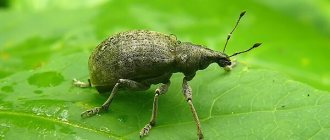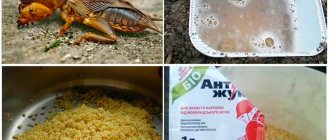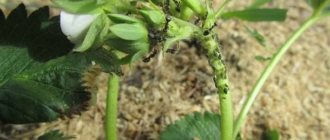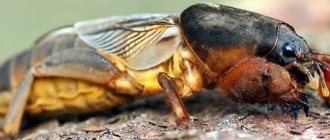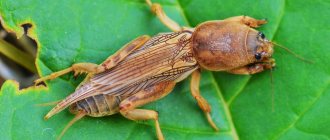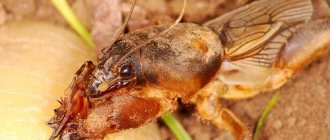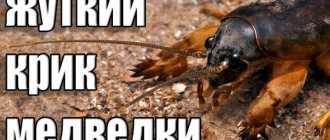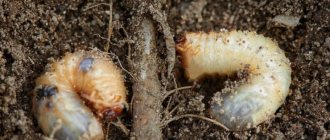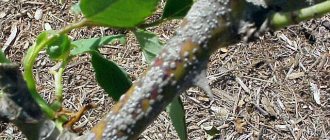The invasion of this pest can only be compared with an invasion of locusts. The mole cricket is an insect that can deprive a garden of crops in a short period of time, not disdaining either the young roots of seedlings or already ripe root crops. Having noticed a voracious pest, gardeners should sound the alarm, because they will not be able to get rid of it quickly. How to get rid of mole crickets in a garden or summer cottage effectively and forever is the topic of today’s article.
Harm
The main danger is the destruction of the crop. Having appeared on the site in single copies, the mole cricket reproduces very quickly. Numerous hordes quickly destroy the harvest of root crops: potatoes, radishes, radishes, carrots, and beets. They do not disdain the young roots of planted seedlings of tomatoes, cabbage, onions and cucumbers lying on the surface of the ground.
It causes great harm to shrubs, eating up plant roots, as well as bulbous plants (tulips, lilies, gladioli, etc.), strawberries, watermelons, melons. The voracious bug feeds not only on plant foods; it also uses earthworms, larvae, and small insects.
It is easy to notice the appearance of insects in the garden. Making their tunnels underground, mounds of earth are visible on the surface of the soil. The pest is especially active in the spring, when the earth warms up. That is why gardeners perceive this insect as their worst enemy. You will have to put in a lot of effort and time to get rid of it forever.
Description
For someone who doesn’t know what a bear looks like, the description may conjure up a scary monster. Considering the amount of damage it can cause, perhaps it is so. The mole cricket belongs to a group of insects, the order Orthoptera. It is not difficult to recognize it in nature - the head is similar to the head of a crayfish, the forelimbs are developed, only instead of claws, the mole cricket has powerful digging organs. The average size of the insect is about five centimeters, but there are individuals the size of the palm of an adult.
Medvedka photo
The front pair of legs of an insect is adapted for digging the ground. The middle ones allow you to run quite quickly. The hind legs are similar to the legs of grasshoppers, but they are not so developed, so the mole cricket, although it jumps, is very low.
Despite the presence of wings, the mole cricket rarely flies, at low altitude, and only if the air temperature is high enough. During cold periods, the insect cannot fly because the wing muscles are weak. A sudden danger, the call of a male, or the need to change its habitat can force the cabbage to fly.
The mole cricket's jaws can gnaw through hard root crops, but the real delicacy for it is the juicy roots of young plants. Several mole crickets can cause significant damage to the crop over the course of a season.
But the biggest danger of these insects lies in their mobility and fertility. Under favorable conditions, mole crickets easily fly over long distances, and as a result, two individuals settling on a site can breed so many offspring that the garden can become a barren desert. The mole cricket reproduces by laying a large number of eggs. From them emerge larvae that can live and develop for several years. From one pair, 200-500 individuals are hatched, and if they are not destroyed in time, they will first feed on the roots of young plants, and then begin to eat root crops. Some of the bear's favorite dishes are potatoes and beets.
How to get rid of mole crickets forever
To get rid of a malicious enemy, folk remedies are often used, which makes it possible to grow organic vegetables. They use various baits, traps, and mechanical collection of insects. Chemical insecticides are used as a last resort.
Traditional methods
- Trap. This method is used when there are not many insects yet. To do this, half-liter glass or plastic containers are buried up to the neck in the ground. Vegetable oil mixed with karbofos, honey, and beer are added to the trap by about a quarter to a third of the volume. The insect is attracted by these smells, it moves into the jar, but cannot get back out along the slippery walls. All that remains is to collect the insects in a jar and destroy them.
- Soap solution. This method is used when a nest with a mole cricket is found. Take 50-60 g of laundry soap, grate it or take the same amount of washing powder, dilute it in 10 liters. A large amount of soap solution is poured into the burrows, filling all the passages with the solution. This method makes it possible to destroy not only adult individuals, but also larvae hidden in the farthest corners of underground passages.
- Using eggshells . Collect egg shells throughout the winter. As soon as it gets warmer outside, make a bait. Dry the shells, chop them and “fry” them in a frying pan with sunflower oil. When planting plants (potatoes, cabbage seedlings, tomatoes), add the prepared mixture to the holes. This mixture will not only enrich the plants with minerals, but will also kill insects.
- Manure use . The method is used for large numbers of pests. First, small holes are made in the beds, fresh manure is placed there, and the top is covered with a board. Female mole crickets really like such warm places; they lay eggs there. After 2-3 weeks, lifting the board you will see a cluster of insects there; they are collected and burned. You can do this in the spring. And in the fall, when frost sets in, heaps of manure along with insects are scattered around the garden; mole crickets quickly die from the cold.
- Onion peel . It can also be collected throughout the winter. In the spring we make an infusion with it. To do this, pour several handfuls of 10 liters of water and leave to infuse for a week. After this period, dilute the infusion in a ratio of 1:5 with water and pour plenty of soil.
- Plain water . After rain, the beds are shed even more with water, and the top is covered with dark, durable material (boards, slate, cardboard, linoleum). After 12-16 hours, lifting the covering material, you will see a cluster of mole crickets crawling out of the flooded passages.
- The vibration and noise produced by iron pipes dug into the beds drives the bugs away from their “home.” Metal pipes must be at least 2-3 meters long, and metal propellers are installed on them. Under the influence of wind, the propeller rotates, making noise and vibration, forcing insects to leave their places.
- The unpleasant odors that insects dislike so much emanating from marigolds force them to leave these areas. Just like fish remains embedded in insect passages, pine needles laid out along the perimeter of the beds.
- Vegetable oil. It is also used for filling passages and tunnels. For this, 1 tbsp. l. add oil to a 3-liter jar of water and fill the passages.
Surprisingly, some cats are great at catching mole crickets and feasting on them. So, if the family has pets, they can help the owners in the fight against harmful insects.
Insecticides for the destruction of mole crickets
No less effective in the fight against voracious insects are chemical agents - insecticides. Nowadays there is a wide variety of them on sale. Having chosen a drug, before using it, be sure to read the instructions for use and follow the recommendations. Available for sale:
- Medvetox,
- chops,
- Grizzly,
- Bankol,
- Phenoxin Plus,
- Boverin,
- bugbear,
- Thunder et al.
Distribution and habitat
The habitat of the cabbage plant is wet places. It is usually found in floodplains of rivers and other bodies of water.
The common mole cricket lives throughout Europe except Norway. Its distribution range extends to western Asia. Residents of North Africa, Transcaucasia, Kazakhstan and Kyrgyzstan know firsthand about this insect. In the Russian Federation, it is found in regions located in the European part. The exception is some northern and northeastern regions.
How to prevent the appearance of mole crickets on the site?
It is clear that it is easier to prevent than to later deal with pests on the site. What can be done as a preventive measure?
- By digging up the ground in the fall, we destroy the passages and burrows of pests. Larvae and adults do not like cold weather, so before they go deep into the ground for the winter, the soil is dug up at least as deep as a spade. Digging up the soil in the spring, we collect bugs, which, after hibernation, are chosen closer to the warmth. They are collected and destroyed.
- Do not get carried away with organic fertilizers, especially fresh manure, a favorite habitat for pests. In addition to bringing the mole crickets onto the site with manure, you will also infect the potatoes with fusarium.
- Pests love dry, sun-warmed soil. Mulch the plantings, the mole crickets will go to a warmer place.
- Plant bulbous flowers and elite varieties of plants on plastic nets, boxes with holes or in containers with a cut bottom. Insects will not reach the roots.
- Plant sharp-smelling plants around the perimeter of the plot or beds: marigolds, chrysanthemums, calendula, garlic, parsley, cilantro. The more of them planted, the less likely it is that you will get a mole cricket.
- Make birds, cats, hedgehogs, and lizards your allies in the fight against the mole cricket. For them it is a real delicacy.
Dear readers, watch this video to learn how to fight mole crickets.
I wish you good harvests!
Features of pest control
The mole cricket lives in the soil and rarely comes to the surface at night. Long winding passages go 20-25 cm deep; the exits of the burrows, bordered by piles of earth, are visible in different places in the garden. Nests with clutches of eggs and larvae, pantries with supplies of the pest are also located in the ground.
The insect has a well-developed sense of smell, and thanks to its wings, the cabbage fly flies from site to site at night. The pest is tenacious, quickly adapts to various conditions, sensing danger, and quickly escapes into the depths of numerous burrows.
To destroy mole crickets in the garden, you need to use specific means - traps, baits, strong-smelling solutions.
Favorite plants
It is difficult to name crops that the mole cricket does not like. She loves to chew on everything that gets in her way. A list of the most popular can be seen below.
New potatoes
The mole cricket loves young potatoes, as their tubers contain a lot of moisture. They are easier to chew and appear in gardens quite early, when there is no other crop yet.
Fodder and sugar beets
This vegetable also attracts cabbageweed. The insect loves sugar. There is a lot of it in fodder and sugar beets, so it eats these vegetables with pleasure.
Carrot
Sweet carrots can also be damaged by mole crickets. At the same time, the tops remain untouched and it is difficult to guess the problem from the outside. However, the carrots themselves are half eaten from the inside or up to the tops.
White cabbage
This vegetable suffers from the invasion of cabbage grass, as it damages its root system. This insect is especially dangerous for seedlings, which can be completely destroyed.
Tomatoes and eggplants
Cabbage grass is also dangerous for nightshade plantings. Having multiplied in the area, the beetle can destroy tomatoes. He feasts not only on the root system, but also on the fruits that are on the ground. Eggplants also fall prey to this insect.
bell pepper
A mole cricket can even live in a greenhouse. The underground part of the bell pepper suffers from its activity. As a result, the plant will wither and die.
Pumpkin
Mole cricket can cause serious damage to plants belonging to this family, such as pumpkin, watermelon, melon, and cucumber. It gnaws through their root system and stems.
Strawberries
Sweet strawberries attract cabbage grass. This beetle also harms the underground part of the plant.
Cereals
The mole cricket eats grains with pleasure. To combat it, it is recommended to use boiled wheat, mixing it with some insecticide at the rate of 2-3% by weight of the dry product.
The insect also feeds:
- oats;
- barley;
- rye;
The kapestyanka also likes corn. The beetle poses a danger to its seedlings. It is also known that in the absence of cereals, its fertility decreases.
